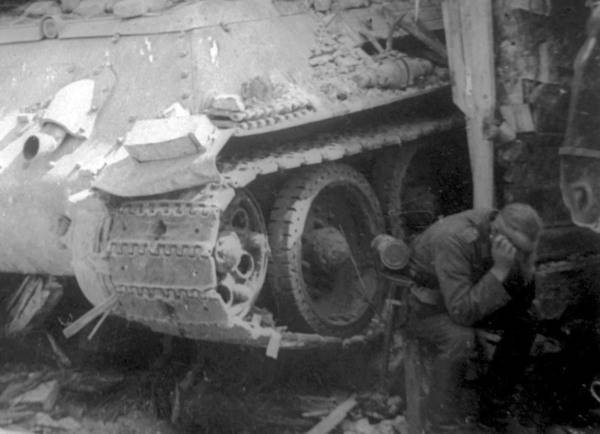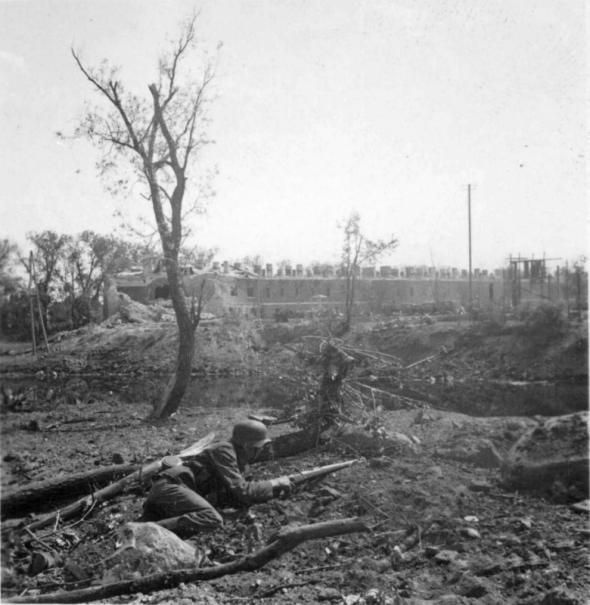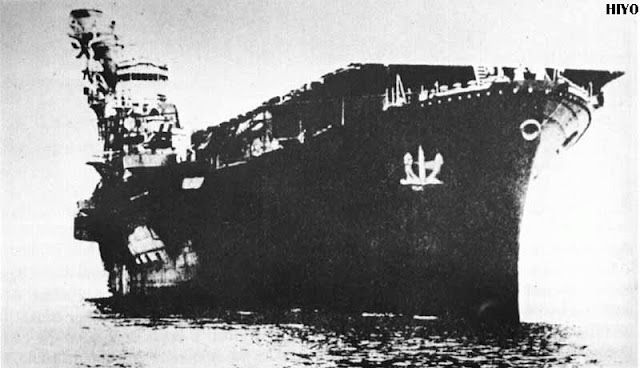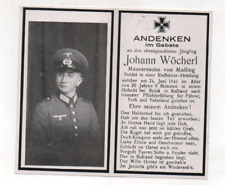Tuesday 24 June 1941
 |
| Staff Sergeant Eero Kinnunen and his Brewster 239 fighter (BW-352) of Squadron Lentolaivue/24 at Selänpää airfield, Kouvola, Finland. 24 June 1941 (colorized). |
Army Group North beats off a powerful Soviet counterattack against 4th Panzer Group at the Battle of Raseiniai. Soviet Lieutenant-General Vasily Ivanovich Morozov takes his 11th Army back to Kaunas on the Niemen. The Soviet 8th Army also is taking a beating.
In Army Group Center, Soviet General Dmitry Pavlov orders his 6th and 11th Mechanized Corps and the 6th Cavalry Corps to attack toward Grodno to stop the panzers. The German 4th Army besieges Soviet defenders at Brest-Litovsk.
The German 3rd Panzer Group, however, already has passed through Grodno and is in Vilnius. Instead, the Soviets hit the following German infantry of V Army Corps of the German 9th Army, supported by Luftwaffe air attacks. This accomplishes nothing.
 |
| Children in a bomb shelter, Minsk, Byelorussia, 24 Jun 1941 (Russian International News Agency). |
The Soviets under General Ivan Bagramyan attempt a counterattack at 04:00 today as part of the Battle of Brody but make no progress. The Soviet 22nd Mechanized Corps attacks toward Voinitsa, but the Germans make quick work of their tanks. Soviet armor and infantry are widely separated and it takes time to assemble them into a cohesive fighting force. The Soviets have powerful forces in the vicinity, but almost all are in the process of forming up today and make no attacks.
The Red Air Force attempts a raid against East Prussia. It accomplishes little. According to the German News Bureau:
An attempt by the Soviet air force on Tuesday morning to fly weak forces into East Prussia, has been frustrated by the German air defense. The enemy aircraft encountered such accurate flak fire that they were forced to turn around at once and to jettison their bombs over open country.The Luftwaffe continues its own raids on Soviet airfields, destroying many planes on the ground. A large fraction of Soviet planes are obsolete, so their destruction is fairly routine for the experienced German pilots. The Luftwaffe bombs Moscow with 100 bombers after dark.
 |
| NY Times, 24 June 1941. |
The Australian 2/14 Battalion tries to advance north from Jezzine. They are stopped cold in the hills north of town by Senegalese defenders who have excellent defensive positions.
The Vichy French make a stand at Jebel Mazar, a tall hill on the Damascus/Beirut road. They stop the British 16th Brigade advancing west from Damascus.
The Vichy French garrison at Palmyra continues its successful defense of the town and airfield. Arab auxiliaries, led by Arab Nationalist leader Fawzi el Kawakji, ambush a British supply convoy in conjunction with French armored cars.
New Zealand light cruiser HMNZS Leander and destroyers Hasty and Jaguar park off the coast north of Beirut and shell Vichy French positions before dawn.
 |
| "British soldiers inspecting a captured German SdKfz 222 armored car, 24 June 1941." (© IWM (E 3776)). |
RAF Bomber Command sends Circus missions to the Thermal Power-Station at Comines. The formation is a success, with 7.5 tons of bombs dropped and the RAF claiming 9 kills, 7 probable kills and 5 damaged aircraft for the loss of two planes and pilots.
Battle of the Baltic: The Soviets scuttle more ships to avoid capture by the advancing Germans, all at Liepāja, Latvia:
- destroyer Lenin;
- submarine M-71
- submarine M-80
- submarine Ronis
- submarine S-1
- submarine Spidola
- torpedo boat TKA-27
- auxiliary gunboat Tunguska
- icebreaker Silach.
 |
| Destroyed/abandoned Soviet tanks in western Ukraine, 24 June 1941. |
U-203 (Kptlt. Rolf Mützelburg), on its first patrol out of Kiel, torpedoes and sinks 4956-ton British freighter Kinross of Convoy OB-336. Everyone survives. This is sometimes listed as happening on the 25th.
U-203 also torpedoes and sinks 4402-ton Norwegian freighter Solay of HX-133. All 32 aboard survive.
U-371 (Kptlt. Heinrich Driver), on its first patrol out of Kiel, torpedoes and sinks 4765-ton Norwegian freighter Vigrid. The Vigrid is a straggler from Convoy HX-133. There are 24 deaths, and 14 survivors (some sources say 21 survivors and 28 deaths) have to wait until 7 July before US destroyer Charles F. Hughes finds them.
U-651 (Kptlt. Peter Lohmeyer), on its first patrol out of Kiel, torpedoes and sinks 5297-ton British freighter Brockley Hill. The Brockley Hill is a straggler from Convoy HX-133. Everyone survives.
The Luftwaffe bombs and damages 803-ton British freighter Levenwood off Tees Bay. The Levenwood is taken in tow and makes it to Hartlepool.
Convoy OG-66 departs from Liverpool bound for Gibraltar, Convoy HG-66 departs from Gibraltar bound for Liverpool.
US minesweeper USS Sheldrake is laid down.
 |
| Someone having a bad day, Nemirow, 24-25 June 1941. |
- The Luftwaffe bombs and badly damages tanker Pass of Balmaha, which its crew abandons.
- The Luftwaffe bombs and sinks sloop HMS Auckland, with 34 deaths, 164 survivors (two die later), and 8 wounded.
The Luftwaffe drops leaflets to the besieged Australians in Tobruk which read:
AUSSIESBefore dawn, Royal Navy submarine HMS Utmost lands some Commandos for a mission to destroy a railway line in Italy. The railway is used to bring supplies for shipments to North Africa. Two Commandos, Lt D R Schofield, Royal Fusiliers, and Lance Corporal F C Morgan, row ashore and place charges on the railway line. Then, they return to the waiting submarine. Unfortunately for their mission, their attempt to destroy a passing train fails when the charges fail to explode. Undeterred, the two men row ashore again and fix them. This time, they just blow up the tracks and return to the submarine without incident.
After Crete disaster Anzac troops are now being ruthlessly sacrificed by England in Tobruch and Syria.
Turkey has concluded pact of friendship with Germany. England will shortly be driven out of the Mediterranean.
Offensive to relieve you totally smashed.
YOU CANNOT ESCAPE
Our dive bombers are waiting to sink your transports. Think of your future and your people at home. Come forward – show white flags and you will be out of danger!
SURRENDER!
Turkish freighter Refah, previously torpedoed by an unidentified submarine (almost certainly a Royal Navy one), sinks. There are 168 deaths and 32 survivors.
Royal Navy battleship HMS Warspite, recently damaged by near misses that cause flooding, sails out of the Mediterranean for repairs. It is out of action until January 1942.
The Luftwaffe raids Benghazi and Tripoli.
Battle of the Black Sea: Soviet minesweeper T-208 Shkiv hits a mine and sinks at the Glotova Bank.
 |
| The siege of Brest fortress, June 1941. |
Battle of the Pacific: Captured whaler “Adjutant,” which now has a German prize crew, arrives in New Zealand waters for minelaying operations.
Propaganda: The Germans announce:
Since early Monday morning the Luftwaffe has continued its successful attacks on Soviet military airfields. Large numbers of Russian aircraft were destroyed on the first day of battle, and we can now report that a great many more aircraft have been shot down on the same day.The Soviets paint a very different picture:
Our aerial forces have fought successfully to protect our towns and military installations. They have fought in the air and supported the counterattacks of the ground troops. In the course of the day 51 enemy aircraft were destroyed by our fighter planes and ground defenses. One enemy plane was forced to land at an airfield near Minsk.Neither side provides many specifics about where their forces on the ground are.
Special Operations: Italian submarine Scire launches midget submarines off Malta. The intent is to penetrate Grand Harbour and attack shipping, but the attack fails.
Soviet/German Relations: The Soviets take the German embassy staff south to Kostroma-on-Volga and house them in a worker's settlement. Their destination is Turkey once arrangements are made for the safe conduct of Soviet embassy personnel from Berlin.
German/Soviet Relations: At some point during this week - details are very sketchy - Soviet Premier Joseph Stalin attempts to broker a peace deal with Hitler through a Bulgarian diplomat, Ivan Stamenov. Foreign Minister Molotov has Lavrentiy Beria arrange this by using one of Beria's subordinates, NKVD officer Pavel Sudoplatov, who has a "casual" lunch at a Moscow restaurant with the diplomat. Sudoplatov explains to Stamenov what to say to Hitler. Stalin is willing to offer huge concessions for peace, including Ukraine and all of the areas granted to him in the "secret protocol" to the 23 August 1939 Molotov/Ribbentrop Pact in the Baltic States. Stalin does, though, demand to know why Hitler invaded the USSR.
Hitler turns Stalin down flat and will not even consider the offer. This is one of Hitler's biggest mistakes. These revelations were hidden for many years but came to light during the period after Stalin died from natural causes in the 1950s. There are few other details of this little-known incident, but there is no reason to doubt that it happened. This peace offer was classified as treason and was one of the charges used to condemn Beria to death. The others involved - including the Bulgarian Stamenov diplomat used as the go-between - submitted affidavits confirming the incident. Sudoplatov confessed to it under interrogation and also was convicted of treason, serving 15 full years in prison (yes, there are many questions about the validity of such "proof," but there was a lot of corroboration). Molotov was never tried for treason despite his deep role in the incident, but gradually fell out of favor, lost his positions one by one, and by 1962 was a "non-person" in the Soviet bureaucracy.
 |
| Original memorial erected to the victims of Einsatzgruppe A at Gargzdai/Garsden/Gorzdt on 24 June 1941 (courtesy of George Birman). |
US/Soviet Relations: President Roosevelt is asked at a press conference what he intends to do about the Soviet Union. He promises to send aid to the Soviet Union, saying:
Of course we are going to give all the aid we possibly can to Russia.It is unclear from this seemingly offhand response what the authorization for such aid would be, though presumably it would be included under Lend-Lease. Roosevelt also unfreezes about $40 million in Soviet assets.
Hungarian/Soviet Relations: Hungary breaks relations with the Soviet Union.
Slovakian/Soviet Relations: Slovakia declares war on the USSR.
German Military: The Wehrmacht begins recruiting volunteers in Denmark, while Spain begins soliciting volunteers (of which there are many) to join a division to fight with Germany on the eastern front.
Finnish Military: While not yet officially at war, the Finns continue laying mines in the Baltic. Finnish troops occupy the Aaland Islands.
Soviet Military: The Leningrad (St. Petersburg) Military District is renamed Soviet Northern Front. Its commander is General Popov. General Aleksei Antonov is appointed Chief of Staff, Southwestern Front.
US Military: In the Philippines, there is flooding at Nichols Airfield (which is not paved), so 3rd and 20th Pursuit Squadrons move to Clark Airfield. The US continues beefing up its presence as transport SS President Pierce arrives bringing 96 pilots.
Joseph Kennedy Jr. enlists in the US Naval Reserve.
 |
| IJN aircraft carrier Hiyō, launched 24 June 1941. |
British Government: With war expenditures soaring, the British House of Commons votes for the second £1,000,000,000 war credit of the year.
Spain: There is strong support in Spain for the German invasion of the Soviet Union. Large demonstrations take place in Madrid and other cities. Spanish Foreign Minister Ramón Serrano Suñer announces the formation of a Spanish volunteer division to serve beside the Wehrmacht in Russia. Volunteers rush to fill the 18,000 openings. Agustin Muñoz Guardes is selected as General commanding this "Spanish Blue Division."
Lithuania: The Lithuanian Activist Front forms a government, but not even the Germans recognize it.
China: The Japanese bomb Chungking (Chongqing).
 |
| German troops at Kaunas (Kovno), Lithuania, 24 June 1941. |
American Homefront: New York Yankee Joe DiMaggio gets a hit in the 8th inning against St. Louis Browns pitcher Bob Muncrief. This extends DiMaggio's club-record hitting streak to 36 games. It is a Yankees blowout (they win 9-1), and the at-bat is meaningless, so some (including Browns manager Luke Swewll) question Muncrief's decision to pitch to DiMaggio. Muncrief, who could have simply walked DiMaggio or hit him with a pitch and ended the streak, says after the game:
That wouldn't have been fair, to him or to me. Hell, he's the greatest ballplayer I've ever seen.Future History: Charles Joseph Whitman is born in Lake Worth, Florida, US. He becomes the infamous "Texas Tower Sniper: on 1 August 1966 at the University of Texas in Austin. During his well-known shooting spree, Whitman (who in his suicide note claims to suffer from migraine headaches and at his autopsy is found to have a brain tumor) kills 16 people (including his wife and mother) and wounds 31 others. Eventually, after a lengthy standoff, the Austin police shoot Whitman dead. Whitman's murder spree adds a 17th victim in 2001 when someone wounded during the attack dies of his wounds.
 |
| German death card for Johann Wocherl, 24 June 1941, perished in Russia. |
June 1, 1941: Farhud Pogrom
June 2, 1941: Massacres on Crete
June 3, 1941: Kandanos Massacre
June 4, 1941: Kaiser Wilhelm Passes Away
June 5, 1941: Death in Chungking
June 6, 1941: Hitler's Commissar Order
June 7, 1941: Commandos Strike at Pessac
June 8, 1941: British Invade Syria and Lebanon
June 9, 1941: Litani River Battle
June 10, 1941: British Take Assab
June 11, 1941: Hitler Thinking Beyond Russia
June 12, 1941: St. James Agreement
June 13, 1941: Lützow Damaged
June 14, 1941: Latvian June Deportations
June 15, 1941: Operation Battleaxe
June 16, 1941: The Old Lion
June 17, 1941: British Spanked in North Africa
June 18, 1941: Turkey Turns Its Back
June 19, 1941: Cheerios Introduced
June 20, 1941: Birth of US Army Air Force
June 21, 1941: Damascus Falls
June 22, 1941: Germany Invades Russia
June 23, 1941: A Soviet KV Tank Causes Havoc
June 24, 1941: Kaunas and Vilnius Fall
June 25, 1941: Finland Declares War
June 26, 1941: Bombing of Kassa
June 27, 1941: Encirclement At Minsk
June 28, 1941: Minsk Falls
June 29, 1941: Brest Fortress Falls
June 30, 1941: Mölders Becomes Top Ace
2020
No comments:
Post a Comment